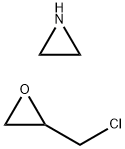POLYETHYLENEIMINE
- CAS No.
- 68307-89-1
- Chemical Name:
- POLYETHYLENEIMINE
- Synonyms
- PEI;POLYETHYLENIMINE, BRANCHED;ETHYLENE IMINE POLYMER;POLYMIN P;EPOMINS(R);ETHYLENEIMINE RESIN;POLYETHYLENIMINE P-70;Paul-Ehrlich-Institut;POLYETHYLENEIMINE ON SILICA BEADS;Polyethylenimine,epichlorohydrinadduct
- CBNumber:
- CB3245697
- Molecular Formula:
- C5H10ClNO
- Molecular Weight:
- 135.59
- MDL Number:
- MFCD00084427
- MOL File:
- 68307-89-1.mol
| Boiling point | 250 °C(lit.) |
|---|---|
| Density | 1.08 g/mL at 25 °C |
| vapor pressure | 9 mm Hg ( 20 °C) |
| refractive index |
n |
| Flash point | >230 °F |
| form | Viscous Liquid |
| color | Clear |
| Sensitive | Hygroscopic |
| CAS DataBase Reference | 68307-89-1 |
| NCI Dictionary of Cancer Terms | PEI |
| EPA Substance Registry System | Aziridine, homopolymer, reaction products with epichlorohydrin (68307-89-1) |
POLYETHYLENEIMINE Chemical Properties,Uses,Production
Chemical Properties
Clear yellow to amber solution
Industrial uses
Polyetherimide (PEI) is an amorphous engineering thermoplastic characterized by high heat resistance, high strength and modulus, excellent electrical properties that remain stable over a wide range of temperatures and frequencies, and excellent processibility. Unmodified PEI resin is transparent and has inherent flame resistance and low-smoke evolution. The resin is produced as Ultem.
Polyetherimide resin is available in an unreinforced grade for general-purpose injection molding, blow molding, foam molding, and extrusion, in four glass-fiber-reinforced grades (10, 20, 30, and 40% glass), in bearing grades, and in several high-temperature grades. The unreinforced grade is available as a transparent resin and in standard and custom colors.
A key feature of polyetherimide is maintenance of properties at elevated temperatures. Polyetherimide has good creep resistance as indicated by its apparent modulus of 2403 MPa after 1000 h at 82 C under an initial applied load of 34.3 MPa.
The resin resists a broad range of chemicals under varied conditions of stress and temperatures. Compatibility has been demonstrated with aliphatic hydrocarbons and alcohols including gasoline and gasohol, mineral salt solutions, dilute bases, and fully halogenated hydrocarbons. Resistance to mineral acids is outstanding. The polymer is attacked by partially halogenated solvents such as methylene chloride and trichloroethane and by strong bases.
POLYETHYLENEIMINE Preparation Products And Raw materials
Raw materials
Preparation Products
| Supplier | Tel | Country | ProdList | Advantage | |
|---|---|---|---|---|---|
| GIHI CHEMICALS CO.,LIMITED | +8618058761490 | info@gihichemicals.com | China | 49999 | 58 |
| Sigma-Aldrich | 021-61415566 800-8193336 | orderCN@merckgroup.com | China | 51471 | 80 |
| Wuhan Excellent Voyage Chemical Co.,Ltd. | 18771133548 | 3287174834@qq.com | China | 207 | 58 |
| Shenzhen Popeye Biotechnology Co. Ltd. | 0755-86320212 | popeye02@qq.com | China | 310 | 58 |
| Shaanxi DIDU pharmaceutical and Chemical Co., Ltd | 15229059051 | 1027@dideu.com | China | 9926 | 58 |
| Shanghai Saikerui Biotechnology Co. , Ltd. | 021-58000709 15900491054 | info@scrbio.com | China | 9260 | 58 |
| Shanghai Beiwanta Biotechnology Co., Ltd. | 021-67187366 19901745723 | info@bwtlab.com | China | 9240 | 58 |
68307-89-1(POLYETHYLENEIMINE)Related Search:
1of4





